Anuradhapura Sacred City Tour
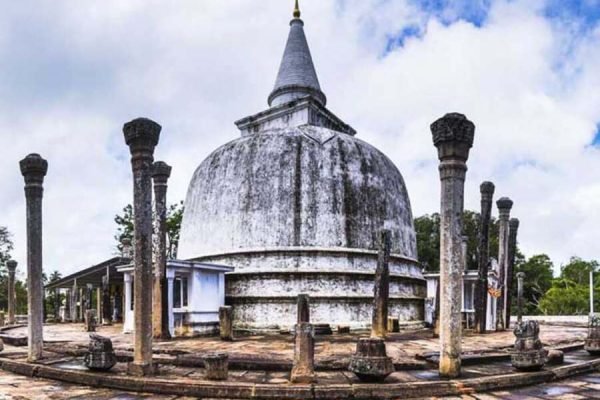
Location : North Central province, Sri Lanka
Coordinates : 8°20′6″N 80°24′39″E
Elevation : 500 m
Avg temperature : 25c to 40c
Humidity : 75% to 85%
Governing body : Urban Council
Official name : Sacred city of Anuradhapura
Type: Cultural
Criteria : ii, iii, vi
Inscription : 1982
Reference no. : 200
UNESCO Region : Asia-Pacific
Anuradhapura, located in the North Central Province of Sri Lanka, is a city that holds immense historical and cultural significance. It was the first capital of ancient Sri Lanka and is considered one of the oldest continuously inhabited cities in the world. With its rich heritage and archaeological wonders, Anuradhapura is a must-visit destination for history enthusiasts and spiritual seekers alike.
Anuradhapura city is a UNESCO World Heritage Site for its well-preserved ruins of the ancient Sinhalese civilization. It is located in the north-central province of Sri Lanka.
Let’s discuss History in short about Anuradhapura before we start the tour. You will enjoy the tour once you know the highlights of history.
Anuradhapura was the vital capital of the early kingdoms of Sri Lanka (500 BC to 1000 AD). It is the first monarchy and third kingdom after Thambapanni and Upatissa. King Pandukabhaya created Anuradhapura’s capital in 504 BC.
The Anuradhapura period is vital for significant changes in Sri Lanka. A proper administration system, religious influence, cultural aspects, and economic growth are needed, such as foreign trading, ancient irrigation systems, and invasions.
Indian Emperor Asoka introduced the Monarchy system to Sri Lanka during the reign of King Devanampiyatissa in 307 BC. King Devanampiyatissa was the first king to have a coronation under the guidance of Emperor Asoka, who introduced the Monarchy system to Sri Lanka. The commentary of Mahawamsa (the chronicle for the history of Sri Lanka) says that when appointing a king in the earliest days, the king was presented with the Royal stick or wand as the symbol of Royal leadership, but no coronation was held.
At the same time, introducing Buddhism was a turning point in the island’s history from Emperor Asoka to King Devanampiyatissa. King Devanam Piyatissa converted to Buddhism after listening to the sermon from Arahath Mahinda (Mahendra), son of Emperor Asoka. Sri Lankan people embraced Buddhism following their king, Devanampiyatissa. Then, King Devanampiyatissa requested a sapling of the Sacred Tree (Ficus religiosa) sapling that sheltered Buddha to gain enlightenment and planted it in Anuradhapura. Nun Sangamiththa, daughter of King Ashoka, brought it. King Devanampiyatissa converted his game reserve, Mahamewuna Garden, to a monastery for Buddhist monks named Maha Vihara. Monastery in Sri Lanka started from there onwards. Prince Dantha and Princes Memamala brought the Sacred Tooth Relic of Buddha, as advised by King Guhasiva India, due to innovations in 4th century AC. The relic was received by King Kithsirimevan (Megavanna) in Sri Lanka.
Anuradhapura was a walled city with the most ancient constructions, such as Brazon Palace. Engineering and architecture were rapidly developed for the construction of monasteries. The Kings wanted to decorate them with beautiful carvings; you will see many carvings in the sacred city.
Ancient irrigation systems rapidly developed in the Anuradhapura era. It is believed that when the Aryans came to Sri Lanka, the local people engaged in agriculture on a smaller scale. Rice and curry have been staple foods since the ancient period. Rice cultivation requires perennial water for a whole year. But Anuradhapura is in the dry zone in Sri Lanka. They are required to store rainwater that falls only three months a year. They made tanks for storing and distributing rainwater. King Pandukabaya built the first tank in the 4th century BC. There were once 18,000-30,000 small tanks in Sri Lanka, with 90% organized into clusters or cascades. But today, only 14,421 active tanks and 1,661 cascades are estimated to remain.
Anuradhapura has thrived under 122 kings and queens who ruled the country from Anuradhapura for nearly 15 centuries. Pandukabhaya, Devanampiyatissa, Ellalan (Elara), Dutugamunu, Valagamba, Wasabha, Mahasen, Buddhadasa, Dhatusena, and Kashayapa are notable Kings for their services to the country. You will hear some of them on the tour.
Let’s explore some significant places in Anuradhapura.
Jaya Sri Maha Bodhi

Jaya Sri Maha Bodhi is a Sacred Fig tree (Ficus religiosa) in Anuradhapura sacred city. It is said to be a sapling from the historical Bodhi tree under which Buddha became enlightened. It was planted in 288 BC and is said to be the southern branch of the Sri Maha Bodhi Bodhgaya India; it is also the oldest living human-planted tree in the world with a known planting date. The sacred tree was brought by the Nun Sangamitta, the sister of Arahath Mahinda, daughter of King Ashoka India, who introduced Buddha’s teachings to Sri Lanka.
Thuparamaya

King Devanampiyatissa built Thuparamaya in the 4th century BC, where the collarbone of the Buddha was enshrined. Thuparama stupa is the oldest stupa in Sri Lanka. It is a Buddhist sacred place of reverence. This is considered the earliest monument, the construction of which was chronicled in Sri Lanka. Thuparamaya comes from “stupa” and “aramaya,” a residential complex for the monks.
Ruwanwelisaya
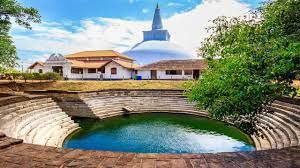
The Ruwanwelisaya is a stupa by King Dutugemunu in the 2nd century BC Anuradhapura. It is considered a marvel for its architectural qualities and is sacred to many Buddhists worldwide. King Dutugamunu became lord of all of Sri Lanka after a war in which the Chola King, Ellalan (Elara), was defeated. Also, King Dutugemunu didn’t live to see the completion of the stupa, but his final sight as he lay on his deathbed could be a false bamboo-and-cloth finish placed around the stupa to show his ‘completed’ masterpiece.
Lovamahapaya (Brazen Palace)
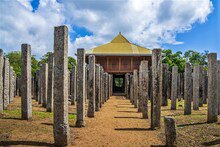
Lovamahapaya is a building between Ruvanveliseya and Sri Mahabodiya in the ancient city of Anuradhapura. King Dutugemunu initially built it in the 2nd century BC, but throughout the ages, it was rebuilt many times, each time a little less grandiosely. All that is left of this vast palace are the remains of 1600 columns. Archaeological evidence says it had nine stories and could accommodate 1000 monks and attendants. The current stand of pillars remains from the last rebuild of King Parakramabahu around the 12th century.
Mirisavetiya
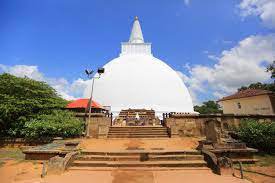
King Dutugamunu built the Mirisaveti Stupa after defeating King Ellalan (Elara) in the 2nd century BC. The extent of this land is about 50 acres (20 hectares). Although King Kasyapa I and Kasyapa V renovated this, from time to time, it was dilapidated. What stands today is the renovation done by the Cultural Triangle Fund.
Abhayagiriya
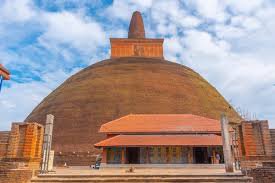
King Valagamba built the Abayagiri stupa in the 1st century BC. It is one of the most extensive ruins in the world and one of the most sacred Buddhist pilgrimage cities. Historically, it was a great monastic center and royal capital, with magnificent monasteries rising to many stories and roofed with gilt bronze or tiles of burnt clay glazed in brilliant colors. To the north of the monastery, encircled by great walls and containing elaborate bathing ponds, carved balustrades, and moonstones, stood “Abhayagiri,” one of seventeen such religious units in Anuradhapura and the largest of its five major viharas.
Lankaramaya
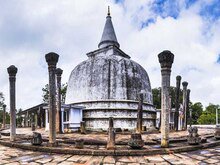
Lankaramaya is a stupa built by King Valagamba in the 1st century BC. Nothing is known about the ancient form of the stupa, which was later renovated. The ruins show rows of stone pillars, and there is no doubt that a house was built encircling the stupa (Vatadage) to cover it.
Jetavanaramaya
![Jetavanaramaya was the world's tallest stupa,[3] and the third tallest structure in the world (only behind the two great pyramids: Great Pyramid of Giza and Pyramid of Khafre)](https://pantheratravels.com/wp-content/uploads/2024/03/Jethawanaramaya-1-220-144.jpg)
King Mahasen initiated the stupa’s construction following the destruction of Mahavihara in the 3rd century AD. His son Meghavanna resumed the work. The relic enshrined here is believed to be a part of a sash or belt tied by the Buddha.
Archaeologists believe it may have an original height of over 100m, but today, it is about 70m, similar to the Abhayagiri. When it was built, it was the third-tallest monument in the world, the first two being Egyptian pyramids. A British guidebook from the early 20th century calculated that there were enough bricks in the stupa’s brick core to make a 3m-high wall stretching from London to Edinburgh.
Behind it stand the ruins of a monastery that could accommodate around 3000 monks, and one building has doorjambs over 8 m high, which is still standing, with another 3 m underground. At one time, massive doors opened to reveal a large Buddha image.
Samadhi Buddha Statue
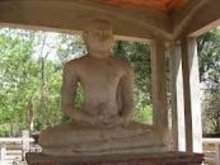
This masterpiece sculpture is located at the Abayagiri monastery in Mahamevna Uyana. It depicts the Buddha in a deep meditation posture carved in dolomite marble. The qualities of Budhha, compassion, loving-kindness, and serenity are beautifully presented on his face. The robe is shown with a simple line. According to the features, archeologists believe it should have been created during the 4th century AD. It was excavated in 1866 and restructured the nose, but it was unsuccessful.
During the full moon day of June, thousands of devotees gather in front of this statue and meditate.
Kuttam Pokuna (Twin ponds)

Twin ponds had been constructed during the middle of the 6th century AD for the use of the monks of Abayagiri monastery. The twin pond is so-called because the two ponds were built in different periods but are shown as single units. The water was taken underground, sent through a silt trap, and connected with underground pipelines. Monks can walk down and have a bath with a clay pot. The used water flows down to the nearby paddy fields. When the ponds were excavated, auspicious symbols made out of gold, silver, and copper were found. Now, they are exhibited at the national museum. The cobra hooded sculpture is believed to be a guardian of the properties associated with water. The full pots, which are very simple in decoration, show Anuradhapura sculpture’s early period. As a whole, it is a unique piece of art and architecture.
You have completed the first part of the tour. You must buy a single-entry ticket for all the above sites.
Let’s start the next part of the tour.
Wessagiriya
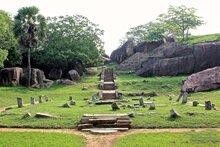
Vessagiriya is an ancient Buddhist Forest monastery that is part of the ruins of Anuradhapura’s sacred city. Begun in the 3rd century BC during the reign of King Devanampiyatissa, the site was expanded during the reign of King Kasyapa in the 5th century AD to accommodate about five hundred monks.
It has 32 caves, where some members of the Royal family lived after they became Buddhist monks. Later, it was developed as a monastery complex along with Isurumuniya. The caves with drip ledges show the ancient hydraulic management, and inscriptions show the people’s language, Characters, and literacy at that time.
Isurumuniya
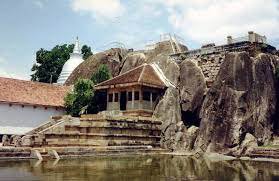
This is a beautiful site beside the Tisa tank. The early history is not known. The ‘Buddha’s Footprints’ show that the history of the place goes back to the Pre-Christian Era when it was a Buddhist temple in the 4th century AD. When the Tooth Relic was brought to Anuradhapura, it was placed here and exhibited for some days. Archeologists believe this was a worshipping place of Parjanya – the Rain god. However, Isurumuiya is famous mainly for its sculptures, and most are non-religious. The bathing elephants with facial expressions of joy, Man and Horse, Famous lovers, Royal family, and many other sculptures, which belonged to the 7th to 9th C.AD.are considered genius works of art of ancient Sinhalese. “The lovers have been interpreted as a son of a great king and his fiancé from a low-cast family, a soldier, and his fiancé. The famous bas-relief at Isurumuniya is a fine specimen representing the naturalistic tendency of early sculpture. The hilt of the sword and the outline of an ornamental shield behind the right shoulder, the sensuous lips and the bulky body, and the thick waist indicate a figure of a human being. – a Soldier”. A quote by Martin Wickramasinha, one of the prominent authors, was in Sri Lanka.
You have to pay for an entry ticket at the gate.
Mihintale
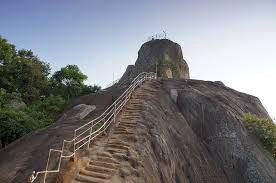
Mihintale is where Buddhism was officially introduced to Sri Lanka on a Poson (month of June) full moon day in 247 BC. Since then, Mihintale has been considered the cradle of the country’s Buddhist civilization. It was the first-ever monastery complex – Rock Monastery. According to the inscription found, this was the oldest recorded official meeting in the world. The meeting between King Devanampiyatissa and Arahath Mahinda was held. The monastery complex has a stupa, ponds, hospital, slab inscription, and caves.
Ancient Hospital Archeological site
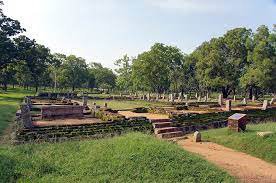
The Ancient Hospital is in the Mihinthale monastery complex. This was built during the 8th century AD for the primary use of monks and the public (OPD). According to an inscription, there were two specialist doctors on bone and fractures and another for the ailment using leaches. According to the ruins of the hospital, archeologists say there was a reception, OPD, Specialist rooms, storehouses, sauna/steam bath, Oil/herbal bath open-door wards for residential monks, and an Image house of Buddha in the center.
You must pay the entry ticket fee at the main gate of the monastery complex.
Moonstone, Guard stone, and Balustrade (Ancient entrance)
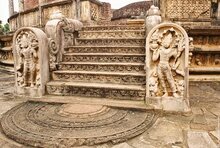
You will see these carvings all over the sacred city, which consists of a complex of moonstones, guard stones, a flight of steps, and balustrades.
A moonstone is a simple semicircular slab or stone slab at the foot of a flight of steps at the entrance of a building. From the Anuradhapura period to the last kingdom, several moonstones were found as rectangular, round, plain ornamental slabs with half a lotus in the center.
Guard tones are the slabs that serve as pegs, fixed to keep the balustrade from slipping forward. Some scholars say guard tones are part of a completed entrance. They consider that the guard stone brings the greatness of a royal palace or temple building.
Balustrades are stone balustrades located on either side of the stairs leading to the entrance or door of a religious building or structure.
That is the end of the Anuradhapura sacred city tour.
Crucial note: Please wear suitable clothes covering your shoulders and knees. We recommend using temple socks, as the sites are high-temperature (37C), and slippers for ease. You must remove your shoes/slippers and hats while entering sacred places. You are not allowed to take pictures while keeping Buddha statues behind you.
Anuradhapura is a city steeped in history and spirituality, offering a unique glimpse into ancient Sri Lanka. From its sacred temples and stupas to its serene natural beauty, the city has something to offer for everyone. Whether you are a history enthusiast, a spiritual seeker, or simply someone looking to explore a fascinating destination, Anuradhapura is a place that should be.

Hope you enjoyed the article. You can scroll down to our featured posts. Before you go to featured posts, Subscribe to read our new posts. We never use this email for promotions and offers. Our only purpose is for you to read our valuable content.
Featured Blog Posts

- Featured, Places
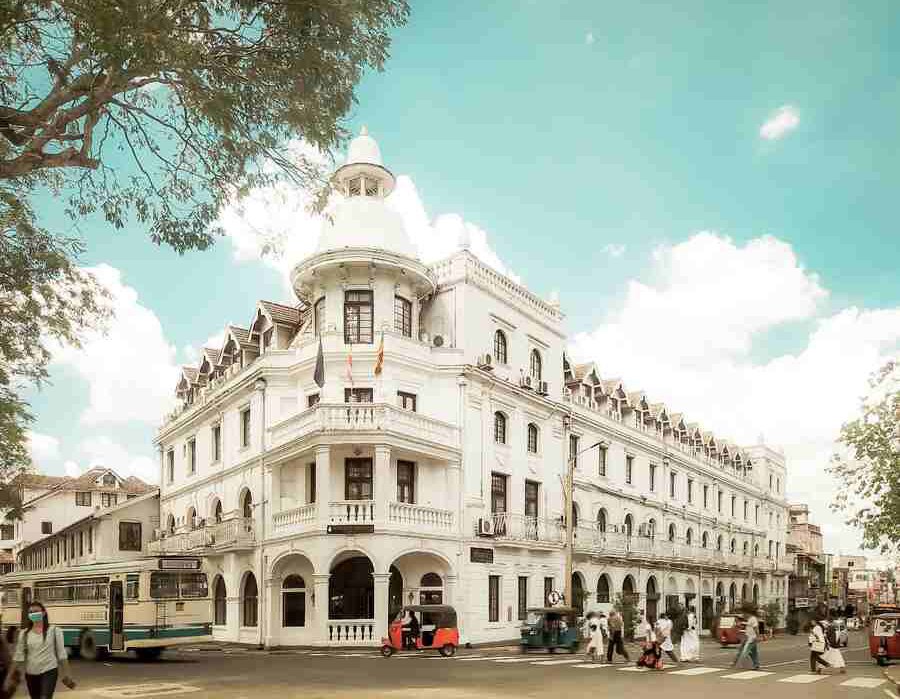
- Featured, Places

- Featured, Travel tips

- Featured, Places
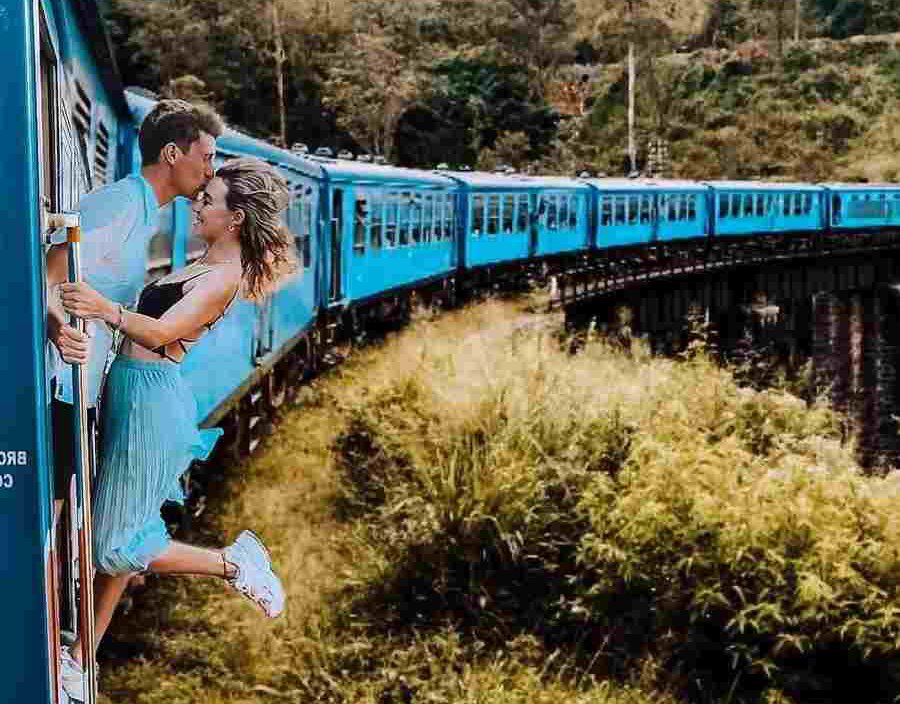
- Activities, Featured

